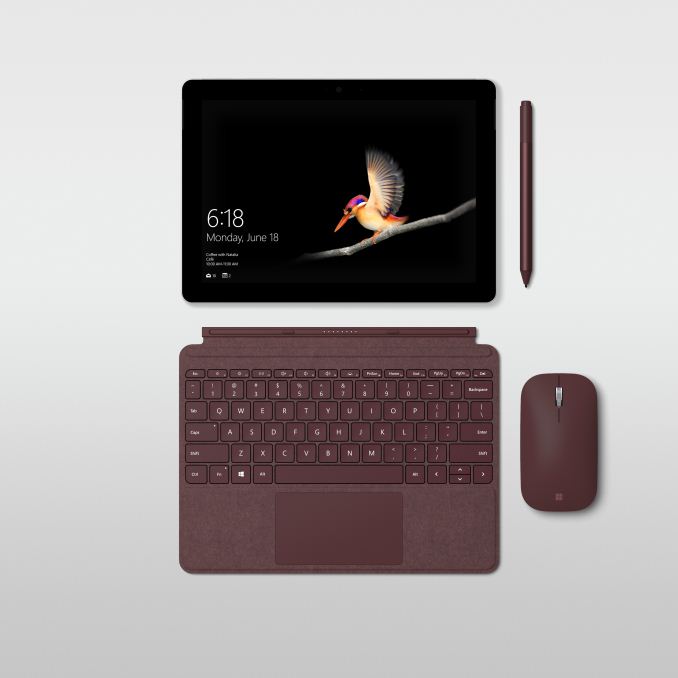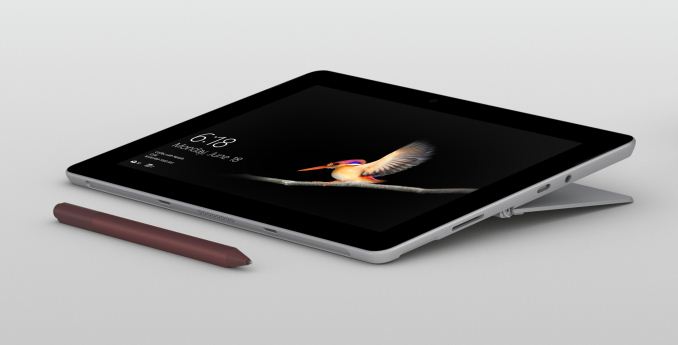Just over three years since the launch of the surprisingly good Surface 3, Microsoft has finally refreshed this category with a new device, now called the Surface Go. The Surface Pro series has been very successful for the company, and they’ve decided it’s time to offer an entry level Surface again. The Redmond company has been working on trying to win back the education market, so a smaller, lighter, and most importantly, less expensive Surface makes a lot of sense.
The Surface Go is the thinnest and lightest Surface yet at just 8.3 mm, down from the 8.7 mm of the Surface 3, and 8.5 mm on the latest Surface Pro, but it undercuts the other models on weight significantly at 521 grams, or 1.15 lbs. That’s a full 31% lighter than the larger Surface Pro.
The display is also smaller, this time coming in at 10-inches in the now familiar 3:2 aspect ratio Microsoft has focused on, and the taller aspect ratio certainly helps on mobile devices such as this that may be used in portrait. It’s an 1800x1200 PixelSense display, with 10-point multi-touch and Surface Pen support. The screen has a reasonable 216 pixels per inch of density, which is pretty much the same as the Surface 3 back in 2015. That’s not quite as high as the Surface Pro or iPad Pro, but should still be fairly clear.
One of the biggest upgrades over the outgoing Surface 3, which was the first of the value-oriented Surface models to ship with an x86 processor, is the move from the quad-core Atom to an Intel Pentium Gold 4415Y. This is a dual-core Kaby Lake processor with four threads, and a 1.6 GHz base frequency. With a TDP of just 6W, it’s not going to be a powerhouse, but it’ll still offer solid performance for a device of this size. The low TDP also means that it can be fanless, which it is. The CPU is coupled with the Intel HD Graphics 615, which offers 24 Execution Units (EUs), although at just 850 MHz maximum boost. Still, that should offer a good jump over the Atom in the previous model.
The base model comes with just 4 GB of LPDDR3-1866, and 64 GB of eMMC storage, although it will be offered in 8 GB RAM versions with 128 GB and 256 GB SSDs, which should offer much better performance.
| Microsoft Surface Go | |||||
| Surface Go Specifications | |||||
| CPU | Intel Pentium Gold 4415Y 2 core, 4 thread, 1.6 GHz base frequency |
||||
| GPU | Intel HD 615 24 Eus 850 MHz boost frequency |
||||
| Display | 10-inch PixelSense 1800x1200 3:2 aspect 10-point Multitouch Surface Pen support |
||||
| Dimensions | 245 x 175 x 8.3 mm 9.6 x 6.9 x 0.33 inches |
||||
| RAM | 4 or 8 GB LPDDR3-1866 | ||||
| Storage | 64 GB eMMC 128 / 256 GB SSD optional |
||||
| Wireless | 802.11ac with Bluetooth 4.1 LTE Optional |
||||
| Battery | Up to 9 hours of video playback 24W Charger |
||||
| Cameras | Windows Hello IR camera 5 MP Front Camera with 1080p video 8 MP Rear Camera with 1080p video |
||||
| Ports | USB Type-C 3.1 Gen 1 Surface Connect MicroSD Headset |
||||
| Price | 4GB/64GB $399 8GB/128GB $549 Windows 10 Pro $50 extra |
||||
The Surface 3 was charged with micro USB, but the Surface Go steps up to the 24-Watt magnetic Surface Connect found on the rest of the mobile Surface lineup, and it also includes a USB 3.1 Gen 1 with a Type C connector, and they’ve kept the expandable storage with MicroSD included.
Microsoft has also included an IR camera for Windows Hello login, along with a 5 MP front camera for 1080p video, and an 8 MP rear camera. For those that want to use it on the go (pun intended) there will be an LTE model available too, which makes sense with Microsoft’s push towards Always Connected PCs.
Microsoft is claiming up to 9 hours of battery life which they tested doing video playback on the top end model.
Microsoft is also launching a new Surface Type Cover for the smaller model, featuring the same Alcantara as its larger siblings, or as just black if you prefer that. Microsoft has also found a way to fit their full-friction hinge to the smaller Surface Go, allowing for up to 165° of movement.
The new low-end Surface Go looks like a great replacement for the Surface 3, offering a way into the Surface lineup at a much more affordable price. The move to Kaby Lake will be a major boon to performance as well. Prices start at $399 for the base model, $449 for the same model with Windows 10 Pro, or $549 for 8 GB of RAM and 128 GB SSD. The 256 GB and LTE models will ship later. Pre-orders should be available soon.
Source: Microsoft
from AnandTech https://ift.tt/2zzfxCb
via IFTTT



No comments:
Post a Comment